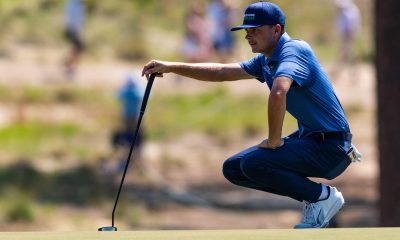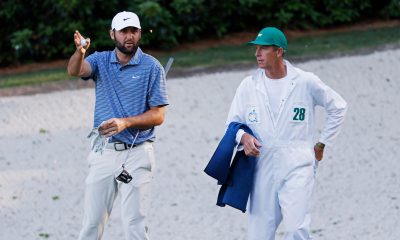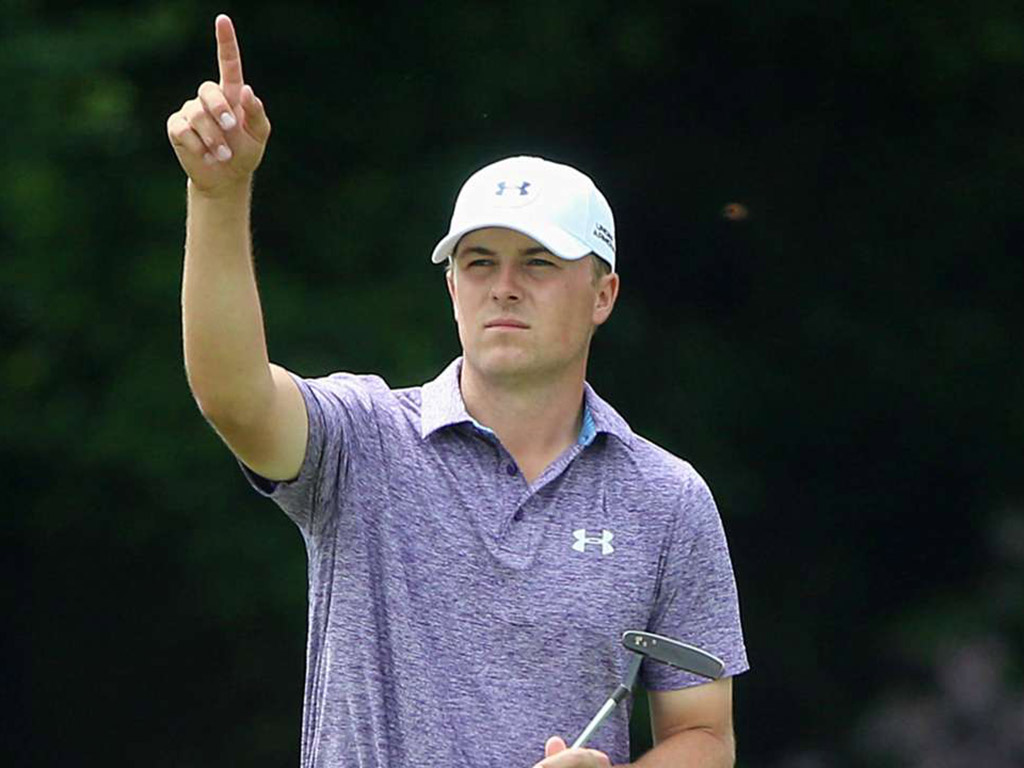Instruction
Haime: Get back to your natural you

I have the great privilege of working with some of the world’s leading athletes (including PGA Tour players and other professionals) in the area of mental and emotional development. When athletes, agents and coaches don’t know what’s wrong with a player, they call me to “fix” it.
It has been my experience that the mental/emotional capabilities are always the separator for golfers — surprisingly few spend adequate time developing the skills that will help them take advantage of physical abilities. There’s a reason why many very accomplished performers declare the importance of the mental/emotional “game,” often stating it accounts for a large slice of the performance pie.
And, it’s important to you.
If you want to jump to the next level in golf, it’s not a bad idea to understand what you can do to improve your mental/emotional game. It will directly impact your results and your enjoyment of the game.
During the coming months, I will coach you and provide you with tried and tested approaches — and real-world examples of how to improve your mental and emotional capabilities. You can tailor the approaches and examples to your game and apply the principles.
Let’s start with something simple.
When I sit with players for the first time — the discovery meeting — I try to find out what makes them tick and how well they know themselves. It’s important for the player (you) to intimately know your strengths, limitations, triggers and the source of your abilities. There are original qualities in all players that are the starting point of the development and these natural instincts are not to be tampered with. They are to be protected and built upon by skillful coaches with a solid, simple, fundamental approach.
Think about all the great players through the years and how original each player is — and how different they all are from each other. Willie Park, Hagen, Jones, Hogan, Nelson, Thomsen, Player, Palmer, Nicklaus, Ballesteros, Faldo, Woods. All of these players are completely different, but they all used their original tendencies and instincts to rise to the top of the game. As Arnold Palmer suggests in the recent Dick’s Sporting Goods commercials — all of these players “swing their swing” and carefully crafted their originality into a world-class game.
In my opinion, golf has become so overcoached that many golfers, perhaps you, get separated from their instincts and natural tendencies and the originality is lost. We are currently seeing this idea with Tiger Woods as he analyzes the game to such an extent and puts his trust in a line of coaches or “consultants” and his natural DNA has faded. The skinny, natural genius has become an overcoached, bulky veteran with eroded instincts. You’ve seen it in recent months where one of the greatest players who ever played has hit some shocking shots from inside 20 yards. That’s the result of far too much thinking and not enough playing.
So, like I would with a world-class player, let’s start there with you. What makes you original and what comes naturally to you? What are your tendencies? What are your restrictions? Carefully consider what you do well, your strengths, what you struggle with, your limitations, what might be a great target of quality, fundamental coaching and what might be something that shouldn’t be tinkered with.
As another exercise to start, consider what creates strong negative emotion in you when you play. What makes you hesitate on the course? What frustrates you? What makes you angry? These are all good questions to begin a self-examination to help you understand the player you are — leading to the player you can be. Self-awareness is critical for a golfer as it is for all athletes and performers. It is the first step in development.
Instruction
The Wedge Guy: Beating the yips into submission

There may be no more painful affliction in golf than the “yips” – those uncontrollable and maddening little nervous twitches that prevent you from making a decent stroke on short putts. If you’ve never had them, consider yourself very fortunate (or possibly just very young). But I can assure you that when your most treacherous and feared golf shot is not the 195 yard approach over water with a quartering headwind…not the extra tight fairway with water left and sand right…not the soft bunker shot to a downhill pin with water on the other side…No, when your most feared shot is the remaining 2- 4-foot putt after hitting a great approach, recovery or lag putt, it makes the game almost painful.
And I’ve been fighting the yips (again) for a while now. It’s a recurring nightmare that has haunted me most of my adult life. I even had the yips when I was in my 20s, but I’ve beat them into submission off and on most of my adult life. But just recently, that nasty virus came to life once again. My lag putting has been very good, but when I get over one of those “you should make this” length putts, the entire nervous system seems to go haywire. I make great practice strokes, and then the most pitiful short-stroke or jab at the ball you can imagine. Sheesh.
But I’m a traditionalist, and do not look toward the long putter, belly putter, cross-hand, claw or other variation as the solution. My approach is to beat those damn yips into submission some other way. Here’s what I’m doing that is working pretty well, and I offer it to all of you who might have a similar affliction on the greens.
When you are over a short putt, forget the practice strokes…you want your natural eye-hand coordination to be unhindered by mechanics. Address your putt and take a good look at the hole, and back to the putter to ensure good alignment. Lighten your right hand grip on the putter and make sure that only the fingertips are in contact with the grip, to prevent you from getting to tight.
Then, take a long, long look at the hole to fill your entire mind and senses with the target. When you bring your head/eyes back to the ball, try to make a smooth, immediate move right into your backstroke — not even a second pause — and then let your hands and putter track right back together right back to where you were looking — the HOLE! Seeing the putter make contact with the ball, preferably even the forward edge of the ball – the side near the hole.
For me, this is working, but I am asking all of you to chime in with your own “home remedies” for the most aggravating and senseless of all golf maladies. It never hurts to have more to fall back on!
Instruction
Looking for a good golf instructor? Use this checklist

Over the last couple of decades, golf has become much more science-based. We measure swing speed, smash factor, angle of attack, strokes gained, and many other metrics that can really help golfers improve. But I often wonder if the advancement of golf’s “hard” sciences comes at the expense of the “soft” sciences.
Take, for example, golf instruction. Good golf instruction requires understanding swing mechanics and ball flight. But let’s take that as a given for PGA instructors. The other factors that make an instructor effective can be evaluated by social science, rather than launch monitors.
If you are a recreational golfer looking for a golf instructor, here are my top three points to consider.
1. Cultural mindset
What is “cultural mindset? To social scientists, it means whether a culture of genius or a culture of learning exists. In a golf instruction context, that may mean whether the teacher communicates a message that golf ability is something innate (you either have it or you don’t), or whether golf ability is something that can be learned. You want the latter!
It may sound obvious to suggest that you find a golf instructor who thinks you can improve, but my research suggests that it isn’t a given. In a large sample study of golf instructors, I found that when it came to recreational golfers, there was a wide range of belief systems. Some instructors strongly believed recreational golfers could improve through lessons. while others strongly believed they could not. And those beliefs manifested in the instructor’s feedback given to a student and the culture created for players.
2. Coping and self-modeling can beat role-modeling
Swing analysis technology is often preloaded with swings of PGA and LPGA Tour players. The swings of elite players are intended to be used for comparative purposes with golfers taking lessons. What social science tells us is that for novice and non-expert golfers, comparing swings to tour professionals can have the opposite effect of that intended. If you fit into the novice or non-expert category of golfer, you will learn more and be more motivated to change if you see yourself making a ‘better’ swing (self-modeling) or seeing your swing compared to a similar other (a coping model). Stay away from instructors who want to compare your swing with that of a tour player.
3. Learning theory basics
It is not a sexy selling point, but learning is a process, and that process is incremental – particularly for recreational adult players. Social science helps us understand this element of golf instruction. A good instructor will take learning slowly. He or she will give you just about enough information that challenges you, but is still manageable. The artful instructor will take time to decide what that one or two learning points are before jumping in to make full-scale swing changes. If the instructor moves too fast, you will probably leave the lesson with an arm’s length of swing thoughts and not really know which to focus on.
As an instructor, I develop a priority list of changes I want to make in a player’s technique. We then patiently and gradually work through that list. Beware of instructors who give you more than you can chew.
So if you are in the market for golf instruction, I encourage you to look beyond the X’s and O’s to find the right match!
Instruction
What Lottie Woad’s stunning debut win teaches every golfer

Most pros take months, even years, to win their first tournament. Lottie Woad needed exactly four days.
The 21-year-old from Surrey shot 21-under 267 at Dundonald Links to win the ISPS Handa Women’s Scottish Open by three shots — in her very first event as a professional. She’s only the third player in LPGA history to accomplish this feat, joining Rose Zhang (2023) and Beverly Hanson (1951).
But here’s what caught my attention as a coach: Woad didn’t win through miraculous putting or bombing 300-yard drives. She won through relentless precision and unshakeable composure. After watching her performance unfold, I’m convinced every golfer — from weekend warriors to scratch players — can steal pages from her playbook.
Precision Beats Power (And It’s Not Even Close)
Forget the driving contests. Woad proved that finding greens matters more than finding distance.
What Woad did:
• Hit it straight, hit it solid, give yourself chances
• Aimed for the fat parts of greens instead of chasing pins
• Let her putting do the talking after hitting safe targets
• As she said, “Everyone was chasing me today, and managed to maintain the lead and played really nicely down the stretch and hit a lot of good shots”
Why most golfers mess this up:
• They see a pin tucked behind a bunker and grab one more club to “go right at it”
• Distance becomes more important than accuracy
• They try to be heroic instead of smart
ACTION ITEM: For your next 10 rounds, aim for the center of every green regardless of pin position. Track your greens in regulation and watch your scores drop before your swing changes.
The Putter That Stayed Cool Under Fire
Woad started the final round two shots clear and immediately applied pressure with birdies at the 2nd and 3rd holes. When South Korea’s Hyo Joo Kim mounted a charge and reached 20-under with a birdie at the 14th, Woad didn’t panic.
How she responded to pressure:
• Fired back with consecutive birdies at the 13th and 14th
• Watched Kim stumble with back-to-back bogeys
• Capped it with her fifth birdie of the day at the par-5 18th
• Stayed patient when others pressed, pressed when others cracked
What amateurs do wrong:
• Get conservative when they should be aggressive
• Try to force magic when steady play would win
• Panic when someone else makes a move
ACTION ITEM: Practice your 3-6 foot putts for 15 minutes after every range session. Woad’s putting wasn’t spectacular—it was reliable. Make the putts you should make.
Course Management 101: Play Your Game, Not the Course’s Game
Woad admitted she couldn’t see many scoreboards during the final round, but it didn’t matter. She stuck to her game plan regardless of what others were doing.
Her mental approach:
• Focused on her process, not the competition
• Drew on past pressure situations (Augusta National Women’s Amateur win)
• As she said, “That was the biggest tournament I played in at the time and was kind of my big win. So definitely felt the pressure of it more there, and I felt like all those experiences helped me with this”
Her physical execution:
• 270-yard drives (nothing flashy)
• Methodical iron play
• Steady putting
• Everything effective, nothing spectacular
ACTION ITEM: Create a yardage book for your home course. Know your distances to every pin, every hazard, every landing area. Stick to your plan no matter what your playing partners are doing.
Mental Toughness Isn’t Born, It’s Built
The most impressive part of Woad’s win? She genuinely didn’t expect it: “I definitely wasn’t expecting to win my first event as a pro, but I knew I was playing well, and I was hoping to contend.”
Her winning mindset:
• Didn’t put winning pressure on herself
• Focused on playing well and contending
• Made winning a byproduct of a good process
• Built confidence through recent experiences:
- Won the Women’s Irish Open as an amateur
- Missed a playoff by one shot at the Evian Championship
- Each experience prepared her for the next
What this means for you:
• Stop trying to shoot career rounds every time you tee up
• Focus on executing your pre-shot routine
• Commit to every shot
• Stay present in the moment
ACTION ITEM: Before each round, set process goals instead of score goals. Example: “I will take three practice swings before every shot” or “I will pick a specific target for every shot.” Let your score be the result, not the focus.
The Real Lesson
Woad collected $300,000 for her first professional victory, but the real prize was proving that fundamentals still work at golf’s highest level. She didn’t reinvent the game — she simply executed the basics better than everyone else that week.
The fundamentals that won:
• Hit more fairways
• Find more greens
• Make the putts you should make
• Stay patient under pressure
That’s something every golfer can do, regardless of handicap. Lottie Woad just showed us it’s still the winning formula.
FINAL ACTION ITEM: Pick one of the four action items above and commit to it for the next month. Master one fundamental before moving to the next. That’s how champions are built.
PGA Professional Brendon Elliott is an award-winning coach and golf writer. You can check out his writing work and learn more about him by visiting BEAGOLFER.golf and OneMoreRollGolf.com. Also, check out “The Starter” on RG.org each Monday.
Editor’s note: Brendon shares his nearly 30 years of experience in the game with GolfWRX readers through his ongoing tip series. He looks forward to providing valuable insights and advice to help golfers improve their game. Stay tuned for more Tips!



















Prime21
Mar 3, 2015 at 1:22 am
Swing your swing……love that one! For the general golf population, that means swing your arms and hands at the ball, powder puff your driver out their 205, & sign for that 95 you just carded. Oh wait, get in tune with your emotions and fine tune your mental approach and that 95 magically drop to 72? Not happening.
Was Faldo’s “swing” #1 before he hooked up with Leadbetter? Woods won a Masters by 12 before he hooked up with Butch? If I’m not mistaken, 2000 was arguably the greatest competitive season ever recorded. But was he using “his swing”? Hogan…. well, he had Hogan. How many times did “his swing” change before he found his secret?
If one lacks talent, the easiest excuse is a poor mental game. Now, I am by no means insinuating that the mental game is not important, but in no way can it override poor swing mechanics. Look at a Tour players stable and you see a trusted advisor in swing, fitness, nutrition, mentality, etc. Why? Because one better have each base covered to compete at the highest level. To believe that there are any short cuts is the quickest way to failure. But until your mechanics are sound or at the very least you are happy with your current distance and accuracy levels and your swing is repeatable, the mental fix alone will do you no good.
While its easy to bash Tiger these days, remember sir, without him your company does not exist. While he may be guilty of taking his pursuit of perfection too far, this same desire created the blueprint for the modern day golfer, one who is strong across the board, not merely in one category.
Though your article is well written, as I’m sure your additional ones will be as well. An offer for a quick fix is nothing more than a ploy to sell more books. In your next article can you answer a question for me? A chain is only as strong as its weakest ………?
Philip
Feb 28, 2015 at 7:03 pm
Very interested as these articles evolve. I have been focusing on “my” abilities and staying away from all the noise in the media and forums since last fall. It has been paying dividends this off-season. Know thyself has always been the wall between most people and success in whatever they desire to a larger degree than they would like to admit. As it is just easier to stick to what is visible to a video camera or recording device. Many seem to want to forget that everyone did pretty good long before our modern technological wonders existed. We don’t have to go back to the stone age, but keeping an open mind to simpler things can often result in quicker success.
morty
Feb 28, 2015 at 7:02 pm
I don’t buy it. Author is manufacturing a dilemma.
How does one become “one of the world’s leading authorities in Emotional Intelligence” anyway?
other paul
Feb 28, 2015 at 9:14 pm
I would ask how his relationship is with his wife. If they have been married for 20 years, have some teenage girls and he still likes and loves her, then he might know a thing.
Otherwise he might not be worth listening to.
John Haime
Mar 2, 2015 at 10:20 am
Many thanks for the comment and a quick reply …
I believe you become one of the world’s leading authorities by working with the world’s leading performers and gaining their trust. A bestselling book also doesn’t hurt. Appreciate the comment – but let the work and writing tell the story – the bio is a result of my experience, my successes and my client list.
Just curious – how is using one’s own natural tendencies a manufactured dilemma? Know thyself has been a critical philosophical fundamental from the beginning of time and it applies to everything – including the games we play.
Thanks again for the comment and hope you enjoy the articles moving forward – and they add some value to your game!
Kenny
Feb 28, 2015 at 5:54 pm
Great article love the simplicity to it..I’ve been playing this game for over thirty years and I agree that the game is over analyzed you have so much information out there …companies coming out with different clubs claiming to do this and that …funny that all the hype doesn’t work. The biggest thing today is the golf ball and some of the technology. When I was coming up as a young golfer we had forged clubs and persimmon headed drivers and balata balls if we were lucky to find one…the pro showed you how to grip the club correctly and then said go play….today it’s not like that everything has to match up and in my opinion it has cost some players there career …The thing that I don’t like is that the people teaching the game today as far as swing coaches want to change what a person has and show him the method that they are teaching…wish my old pro was still around he showed you the fundamentals and that was it…we need people that can teach like the did in the old days…unfortunaley most have died off…
Snowman
Feb 28, 2015 at 7:52 pm
Does anyone realize how much better players are today than they were back in the days when everyone just “went out and played their natural swing” or whatever? Might work for Bubba, Phil, Palmer, and Trevino, but not us. It sounds great too — wack a couple on the range, play 18, grab a beer, repeat..But these days that’s a recipe for calling it quits and becoming a club-tec at golf galaxy..I don’t understand why people are so satisfied by picking on pro golfers for doing everything they can to get better..especially when the level of play is so much higher than previous generations
Philip
Feb 28, 2015 at 8:57 pm
What does maximizing your natural abilities have to do with being just plain ole lazy (though many do just want to hit a few on the range, play 18, drink some beer and eat and head home – doesn’t sound like fun to me, but to them maybe it is. We all have a choice after all). I tried the modern methods and nothing really clicked, went back to trying it on my own – golf isn’t rocket science – and it happened to click for myself. Now that I have a basic foundation that is working I can re-read all those books and watch videos, as well as see a new coach at a new course I started last fall. I’m always watching games on the tube and sometimes I notice something and run to grab a club and practice a few swings in my living room.
For some it is doing it yourself, for others a coach, and even for others video and trackman – the trick is to figure out what is the most efficient and effective method for yourself. Horses for courses. Now if I can just get winter to end a month early……
Gloover
Feb 28, 2015 at 5:37 pm
Great, more inner child work. Someone get the empty chair!